Thank you for the invite to speak today. It is wonderful to be in a room with so many leading thinkers and change makers on the journey towards a more renewable energy system.
I would like to acknowledge the traditional custodians of this land, the Kaurna people. We look with deference to their systems of land management that kept ecosystems and climates in balance. My huge respect to their elders past and present.
The why
I want to start my remarks with the why. What’s ultimately on the line.
We will hear a lot today about the economic opportunities associated with emissions reduction and net zero. These opportunities are real and exciting. I will focus on them too.
But we should not lose sight of the fundamental why.
The why that should keep us driving towards a low-emissions future as fast as humanly possible.
The why is our children, our grandchildren, and all the generations to come.
The world has not done enough and is unlikely to do enough, based on the most recent global negotiations, to keep temperature rises within the 1.5 degrees needed to avert serious and potentially irreversible shifts in environmental systems.
Scientists estimate that at 1.5 degrees – which we are on track to reach in the next decade – intense heatwaves will happen at four times the historical rate, and droughts and floods at almost twice the historical rate.[1]
At rises of 2 degrees, which is on the cards between now and 2050 without much more significant ambition from the world to reduce emissions, a bushfire event of the magnitude of our disastrous Black Summer bushfires will be four times as likely to occur.[2] Also at 2 degrees, only 1 per cent of corals in the Great Barrier Reef will survive.[3]
Large parts of the world will become uninhabitable, and the World Bank predicts there will be 143 million climate refugees by 2050 in Sub-Saharan Africa, South Asia, and Latin America alone.
In the words of United Nations secretary-general Antonio Guterres, a “code red for humanity”.
We cannot collectively look the next generation in the eye unless we do better.
More than a gear change
Australia’s economy faces transformative change to meet global and domestic emissions-reduction targets.
The current pace of change is more glacier than gallop.
Emissions are expected to reduce only slightly over the next decade.
Indeed, if we continue on the current emissions-reduction trajectory, we could expect to reach net zero not in 2050 but in 2160.
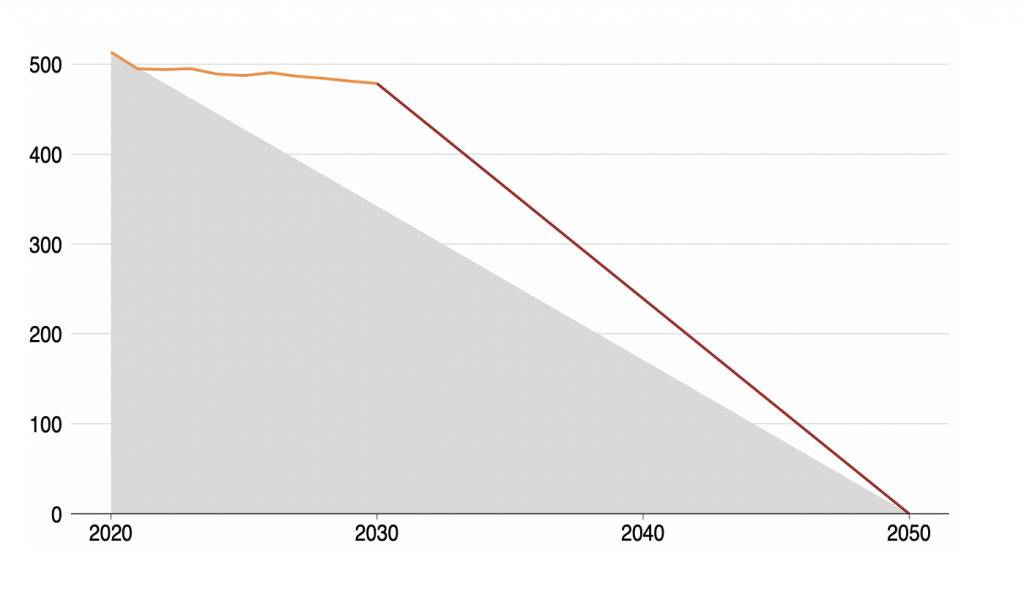
If we do not pick up the pace now, we’ll leave ourselves with a costly and disruptive task to get on the right trajectory through the 2030s and 2040s.
When we look at emissions reductions by sector, the cause of the current challenge is evident.
Emissions are coming down in electricity, although not as fast as we need given the importance of this sector as an emitter and its role in the decarbonisation of other crucial sectors like transport and industrial emissions.
Outside of electricity we have made virtually no progress. We are yet to bend the curve on emissions in industry, transport, agriculture, or in waste.
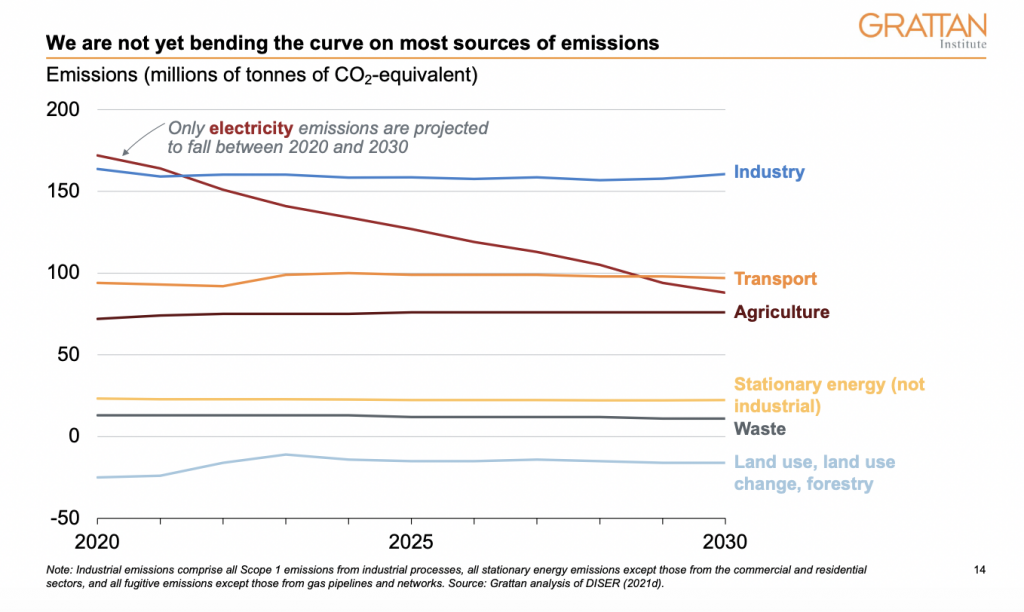
Real progress is going to have to be made in each and every one of these sectors if we are going to shift the dial across the coming decade.
That is why my colleagues at Grattan Institute call it an industrial revolution – with a deadline.
The leadership imperative
This is where I can come to the role of leadership.
One reason we now have such a monumental task ahead is there has been next to no serious, sustained movements in federal policy in the decades since scientists first sounded the alarm bells.
In the past 20 years we had no fewer than 10 emissions-reduction policies introduced and scrapped, or seriously contemplated but falling over at the last hurdle.
It’s a veritable acronym soup – NEG, CET, CPRS, the ETS. All the letters, all the careful policy work and consultation in the end for naught.
Because the leadership wasn’t there to overcome the potency of the scare campaigns.
Political opportunists swarmed like bees to a honey pot, seeking to make climate a party-political issue rather than an economic and engineering challenge.
They mainly succeeded – until now.
Serious steps are now being taken at both federal and state levels to progress policy.
Governments are taking action – because leaders know it is the right thing to do but also because not doing so would leave Australia playing catch up in the green economy.
Our political leaders first and foremost understand that Australians have moved.
Voters nominated climate change as the single most important issue at the 2019 and 2022 elections. This was a huge shift from previous elections.
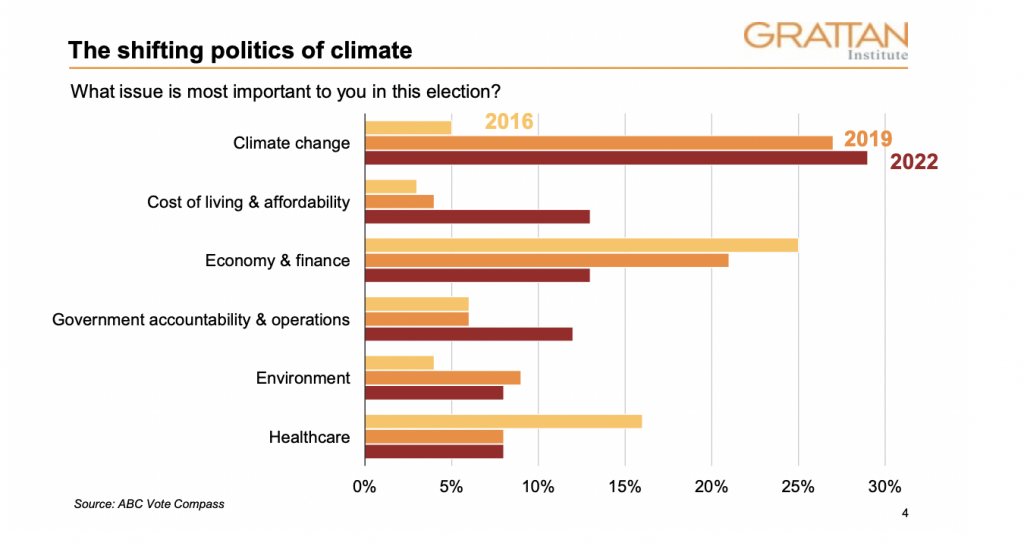
81 per cent of Australians say they are experiencing the effects of climate change first hand.[4]
The other issue that dominates the public mind in elections is invariably the state of the economy. Combining them – climate action as a driver of environmental transformation and economic growth – is a potent force for change, as I’ll come back to.
Renewed leadership is also evident in Australian business. This reflects the reality that sustainability is an important part of social licence in modern economies, but also the economic opportunities that come with decarbonisation.
95 of the ASX 200, around 70 per cent by market capitalisation, now have net-zero targets.[5]
And you can’t swing a cat at business forums without hitting a panel on ESG. Indeed, more than 100 of the biggest listed companies have detailed reporting on ESG measures.[6] Companies like AGL, BHP, Origin Energy, and Santos have linked climate change targets to executive remuneration, or disclosed these as hurdles in corporate scorecards.
Businesses unsurprisingly follow the investment dollars. Bloomberg Intelligence estimates that total global ESG assets are expected to reach $41 trillion by the end of this year.[7] And that is expected to continue to grow significantly in coming years as other investors join the major investment banks in the push into ESG.
This all matters.
My hope is that the combination of government leadership, buy-in from the Australian public, and the concerted efforts of business mean we are ready to bend the curve.
We cannot afford to wait any longer.
The energy goldmine
Ok, now we are ready to roll up our sleeves as a nation? What comes ahead?
Australia has long been blessed with excellent resource endowments.
This land has given us a thriving agricultural sector and a world-class mining sector. Now, as we come to the green revolution, we are similarly blessed.
Australia is home to some of the best renewable supplies in the world. We have regions with lots of wind, lots of sun, and sometimes both. We also have the land necessary to take advantage of these supplies.
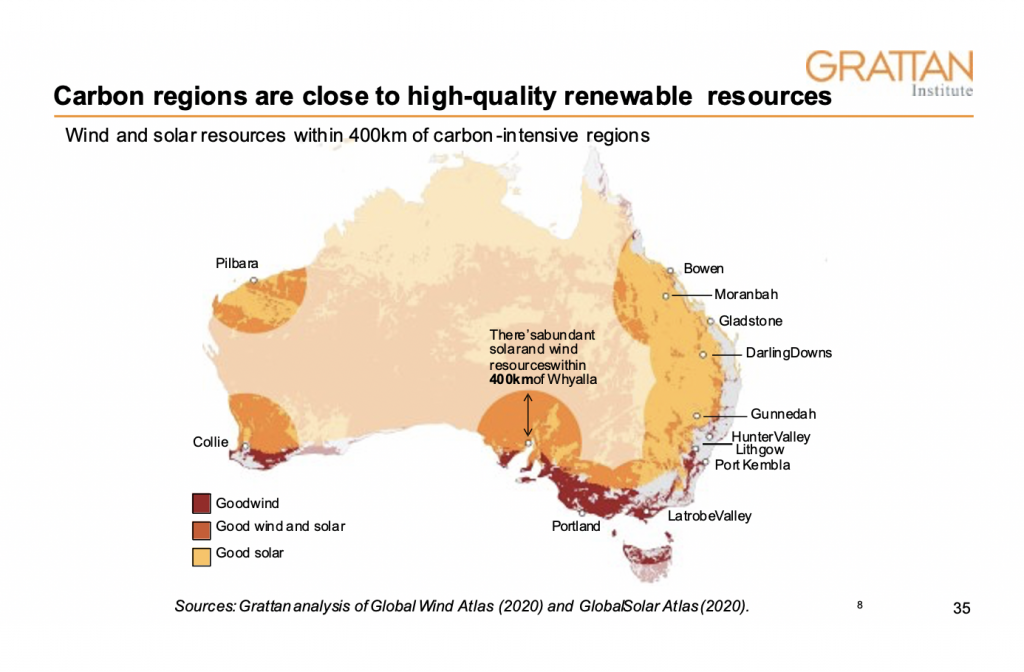
This is especially true in South Australia, which has some of the best solar resources in the world,[8] something that I recall oh too well from long walks home from primary school in the Adelaide summer.
These resources are already being harnessed.
South Australians are enthusiastic adopters of rooftop solar.
In Sydney, people judge you by where you live. In Melbourne, it’s where you went to school. In Adelaide, it’s how many solar panels you have on your roof and when you installed them (double social points if you got in in the early 2000s, triple if it was before feed-in tariffs).
But the commitment goes far beyond this. South Australia has three solar farms in operation and four under construction, generating – along with those rooftop panels – more than 2 gigawatts of solar PV state-wide.[9]
Sitting alongside the world’s biggest battery, this has pushed solar to 20% of the state’s total power generation in 2020-21.[10]
The opportunities that come from these endowments go far beyond the opportunity to generate cleaner energy.
The great green (hydrogen) hope
The Hydrogen Action Plan sets out a vision for South Australia to become a major hydrogen powerhouse, supporting increased penetration of renewable energy (using hydrogen to firm supplies) as well as exporting this energy to the world.
If we are able to establish green hydrogen production at scale, the potential economic benefits are even greater. Hydrogen offers the possibility of transforming existing energy-intensive industries such as steel making and aluminium production.
This isn’t only about greening existing production. In a world where green hydrogen rather than coal is the main energy source, the existing economics of some of these industries is turned on its head.
It’s much more expensive to export energy as hydrogen than coal. This is because coal has more energy per unit of volume than hydrogen does. This means that despite Australia’s higher wages, it might make more sense to produce products like steel here – exploiting Australia’s abundance of both renewable energy and iron ore – and serving massive future global markets for green versions of these products.[11]
In other words, after 40 years of comparative advantage pushing higher value chain activities offshore, for some products this may reverse.
Getting this right will requite careful effort applied to the economics of each supply chain. Just because Australia has large lithium reserves does not mean it should be a mass-market battery manufacturer or build electric cars.
But where the numbers stack up, this can unleash new opportunities. And well managed, these opportunities can centre on the regions that would otherwise be in decline as exports of coal and other carbon-intensive industries take a hit as the world moves to net zero.
Because the parts of Australia with the most carbon workers are also home to high-quality renewables.
They also have the infrastructure and skilled labour that could support new green production.
Less Whyalla wipe-out and more Whyalla white-hot.
The next mining boom
The other massive opportunity for the green economy lies in the supply of critical minerals and rare earth elements.
These are the inputs of the next industrial revolution. Massive growth in global demand for solar panels, wind turbines, batteries, electric vehicles, satellites, and phones, among other things – is forecast to generate extraordinary growth in demand in coming decades.
Lithium demand is expected to grow by more than 4,000 per cent by 2040, and around 2,000 per cent for nickel and cobalt.
By one estimate, at the rate we are going, over the next 30 years the world will need to mine more minerals than were mined over the past 70,000 years.[12]
Where is Australia in all this?
Sitting on 27% of the world’s known lithium reserves, 22% of nickel, 21% of cobalt, and 11% of copper.
South Australia is home to 65% of Australia’s graphite resources – used for batteries and electronics. And the State hosts the world’s largest zircon mine at Jacinth Ambrosia. It has reserves of cobalt, rare earth elements, and magnesium, for batteries, super-conductors, and high-quality metal alloys.
Australia is also home to the world’s most technologically advanced mining industry, and one that is surely well placed to embrace the green mining practices that the market will demand.[13]
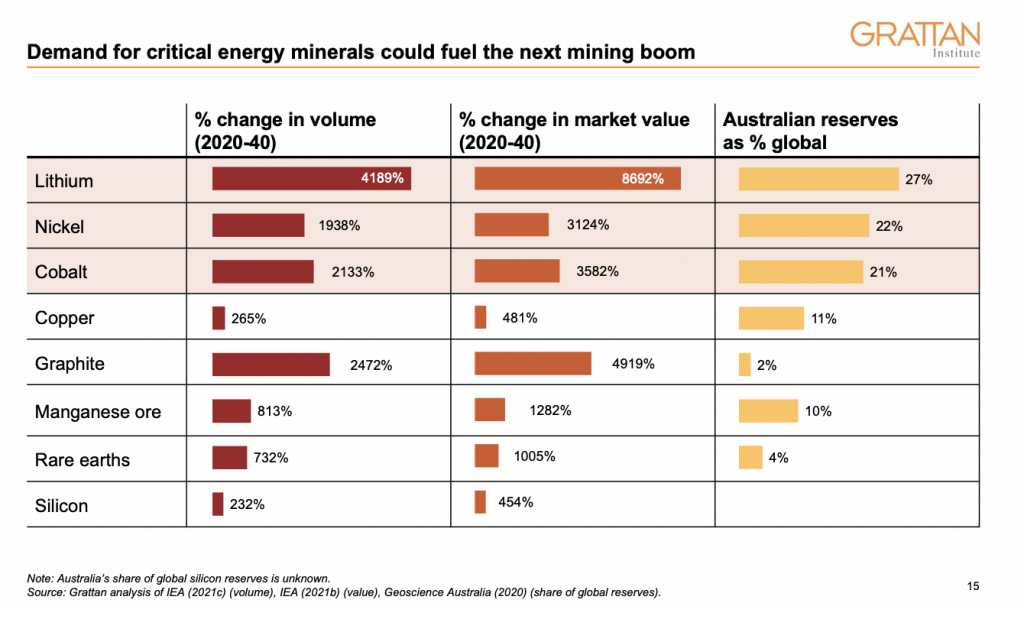
Indeed, as one door closes on the Lucky Country, another one opens. If Australia maintains a constant global share of critical mineral markets, exports of these could be worth double to the Australian economy in 2050 what coal is now.

Moving the roadblocks
The opportunities to become an ‘Energy Superpower’ are huge for Australia and particularly here in South Australia. But it will come with challenges.
First is the speed and scale of what is required.
We are coming into a construction super-cycle at a time when construction pipelines are already chock full of the major transport projects that have been the ‘go to’ for the politicians on the hunt for a vision over the past decade.
Building renewable generation and associated transmission to replace retiring coal plants will compete with other construction projects for workers, materials, and equipment.
If poorly managed, this will drive up the costs of all construction and potentially push out completion dates.
Infrastructure Australia identified this as a risk in 2021, and the bringing forward of the Government’s commitment to accelerate transmission build through the Rewiring the Nation fund will only increase the challenge.
There are also negative knock-on effects from uncoordinated regional construction booms. Competition for labour drives up wages, which in turn drives up rents and property values, pricing locals out of the housing market.
The second, and related, challenge is that taking advantage of these opportunities will require an extraordinary degree of coordination.
Coordination between all three levels of government. Coordination between government, business, and local communities, including indigenous communities. Coordination between business, universities, scientists, and training providers.
Lack of coordination can bite – just look at Gladstone in Queensland when east coast gas exports were beginning. Three LNG export terminals were built in Gladstone by three separate companies, at the same time. There was no co-ordination between them – they don’t even share an access road. Stiff competition among multiple projects drove up local wages until a journeyman carpenter, whose task was to build forms for pouring concrete, could ask for, and get, $250,000 a year.
Coordination is critical for the electricity grid if the lights are going to stay on and heavy industry and transport are going to electrify. It’s not just about building the generation to replace ageing coal as it retires. We also have to build the transmission lines to connect it to the grid.
Your mission, if you choose to accept it…
As an economist, I get a little jumpy when I hear the term ‘industrial policy’. But my colleagues have convinced me that this is exactly the time for a strong industrial policy for Australia.
The economic opportunities from the green transformation are large, but unlocking them depends crucially on planning, coordination, and a healthy dose of foresight.
It depends on governments helping share the risks, and the rewards, of developing and spreading new technologies in areas like green hydrogen.
Innovative thinker and economist Marianna Mazacatto talks about the Mission Economy. Harnessing coordination between government and the private sector to solve wicked social problems.
Climate change is the ultimate wicked problem, and solving it will be the biggest mission our generation undertakes.
I congratulate Premier Malinauskas, and the many others in this, and the previous government, who have placed South Australia at the forefront of this mission. And I congratulate all the business leaders, investors, researchers, and community sector participants who are uniting behind it.
We cannot afford to waste another minute. I along with all your fellow Australians are wishing you the best success.
Footnotes
- Milman, O., Witherspoon, A., Liu, R., and Chang, A. (2021). The climate disaster is here. The Guardian; Levin, K. (2018) Half a Degree and a World Apart: The Difference in Climate Impacts Between 1.5˚C and 2˚C of Warming. World Resources Institute.
- Milman, O., Witherspoon, A., Liu, R., and Chang, A. (2021). The climate disaster is here. The Guardian.
- Australian Academy of Science. (2021). The risks to Australia of a 30C warmer world.
- Quicke, A., and Venketasubramanian, S. (2022). Climate of the Nation 2022: Tracking Australia’s attitudes towards climate change and energy. Australia Institute.
- ACSI. (2022). Promises, pathways & performance: Climate change disclosure in the ASX200. Australian Council of Superannuation Investors.
- ACSI. (2019). ESG Reporting by the ASX200. Australian Council of Superannuation Investors.
- Kishan, S. (2022). ESG by the Numbers: Sustainable Investing Set Records in 2021. Bloomberg.
- SA Department for Energy and Mining (2021). Solar energy in South Australia.
- Ibid.
- Ibid.
- Wood, T., Dundas, G., and Ha, J. (2020). Start with steel: A practical plan to support carbon workers and cut emissions. Grattan Institute.
- Pitron, G. (2020). The Rare Metals War. Scribe US. Similarly, the International Energy Agency estimates that that to hit net-zero globally by 2050, would require six times more mineral inputs in 2040 than today: IEA (2021). The Role of Critical Minerals in Clean Energy Transitions.
- Wood, T and Reeves, A. (2022). Next industrial revolution, Grattan Institute.
While you’re here…
Grattan Institute is an independent not-for-profit think tank. We don’t take money from political parties or vested interests. Yet we believe in free access to information. All our research is available online, so that more people can benefit from our work.
Which is why we rely on donations from readers like you, so that we can continue our nation-changing research without fear or favour. Your support enables Grattan to improve the lives of all Australians.
Donate now.
Danielle Wood – CEO
